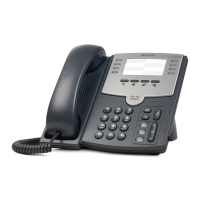Configuring the Cisco SPA500S Attendant Console
Setting Up the Cisco SPA500S Attendant Console
Cisco Small Business SPA300 Series, SPA500 Series, and WIP310 IP Phone Administration Guide 215
9
• sub—Use this keyword to identify the phones to be monitored). Its value and
syntax is stationName@$PROXY, where system variable $PROXY contains the
proxy server IP and port (e.g. 192.168.8.101:6060).
NOTE Unit/key LEDs will not light without the “sub” keyword. (Not required
for speed dials.)
• usr or ext (optional)—Use one of these keywords to identify the specific users
or extensions to be monitored. Its value and syntax is
extensionNumber@$PROXY, where system variable $PROXY contains the
proxy server IP and port (e.g. 192.168.8.101:6060). (The
usr
and
ext
keywords
are interchangeable.) If the ext parameter is not used, all extensions on the
phone are monitored.
• nme (optional)— Use this field with the Cisco SPA 9000 to identify any alias
that has been assigned to the extension in the IP phone configuration.The nme
parameter indicates the extension name, which in this case is the same as the
station name.
• vid (optional)— All LEDs on the Cisco SPA500S use phone extensions that they
are assigned to. By default, LEDs on the Cisco SPA500S are assigned to the
first configured extension on the connected phone. You can optionally assign
LEDs to any other phone extensions using vid=keyword. Use this field to
identify the phone extension to use with the monitored list specified by the
sub= keyword, when more than one BLF monitored list is configured on the SIP
proxy server. The possible values are 1 to 6, corresponding to each of the six
extensions available on the phone. Only use the vid= keyword in the first entry
assigned to each phone extension. Subsequent keys will use the same
extension. See “Attendant Console Parameters” section on page 217.
Assigning Cisco SPA500S LEDs to Phone Extensions
By default, all 32 keys on the Cisco SPA500S are assigned to the first extension on
the IP phone (extension 101 based on the default multicast autoconfiguration).
To limit the number of LEDs assigned to the first extension, use the vid=1 keyword.
Then use the vid=2 keyword to assign the next set of keys to the second
extension. The numeric values correspond to the default extensions on the phone
as follows:
• vid=1—extension 101
• vid=2—extension 102
• vid=3—extension 103
• vid=4—extension 104

